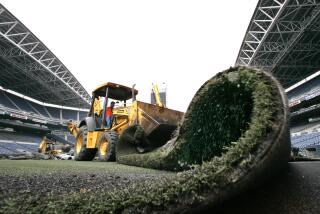California Retrospective: L.A. has long been told to clean up its act
Los Angeles has long been embarrassed about its sloppiness.
This month a city report found that the litter and dumping are so bad that theyâre threatening the Los Angeles brand.
The report generated much attention, but it was not the first time city leaders have tried to get L.A. to clean up its act. In some ways the problem was worse decades ago, when there was still a lot of open space that some residents used as trash dumps.
An expose on littering
âThis city was once one of the cleanest cities in the world. Today it is one of the filthiest.â So began a breathless 1946 three-part expose in The Times about L.A.âs litter problems.
âThe Times feels itâs performing a civic duty in calling to the attention of its citizens these disgraceful conditions, and hopes as a result that enough civic pride will be engendered to correct this unhealthy state of affairs,â the paper wrote in an introduction.
The series ended with a call for âmore civic decency on the part of Los Angelesâ expanding population.â
Freeways as dumps
One big problem in the 1960s and â70s was people dumping trash and debris on freeways under construction.
As officials built the Harbor Freeway, unopened sections were filled with trash and other items. A sweep by police in 1956 netted 20 arrests, and officials found all manner of garbage, including uprooted palm trees.
In 1971, The Times showed tall mounds of trash on a one-mile stretch of freeway under construction in the San Fernando Valley, despite signs warning against dumping.
Bradley declares war
In 1986, Mayor Tom Bradley declared war on litter and dumping.
âThere is nothing more important to neighborhood pride, to the quality of life for the people who live there than to know that their streets and their alleys are going to be clean,â Bradley said, standing next to a wall of garbage in a Watts alley.
The mayor cited South L.A. and the Eastside as having particular problems, especially in alleys, and he vowed to dramatically increase cleanup patrols. Some residents feared the trash was an invitation for criminals and transients.
Dumping on Mulholland
In the 1980s, the canyons around Mulholland Drive became what some well-heeled residents described as garbage dumps.
Mulholland was perfect for dumping because it was remote and poorly lighted. Residents said Saturday night dumping of cars, old tires, furniture and other items was especially common.
âSome Sunday mornings, we look out and try to pick out the cars, the trash bags, the concrete blocks and other junk that has been thrown out the night before,â one resident complained to The Times in 1988.
Blame the housewife
One of the most impassioned pleas for L.A. to clean itself up came in 1910 from Mrs. Hugh W. Hunt.
Her target was not dumping, but overflowing garbage cans. She recommended that housewives remove their cans from the street as soon as the garbage man departs. The cans should be âwashed, scalded and dried after every useâ to avoid becoming foul, she said. âIt is the housewifeâs fault, and decidedly not to her credit, as such, if it does.â
Hunt ended with a rallying cry for the city. âI have passed by groups of cans, covered in flies and sour smelling,â she wrote. âWhat a sight for our visitors from Eastern cities!â
More to Read
Sign up for Essential California
The most important California stories and recommendations in your inbox every morning.
You may occasionally receive promotional content from the Los Angeles Times.










